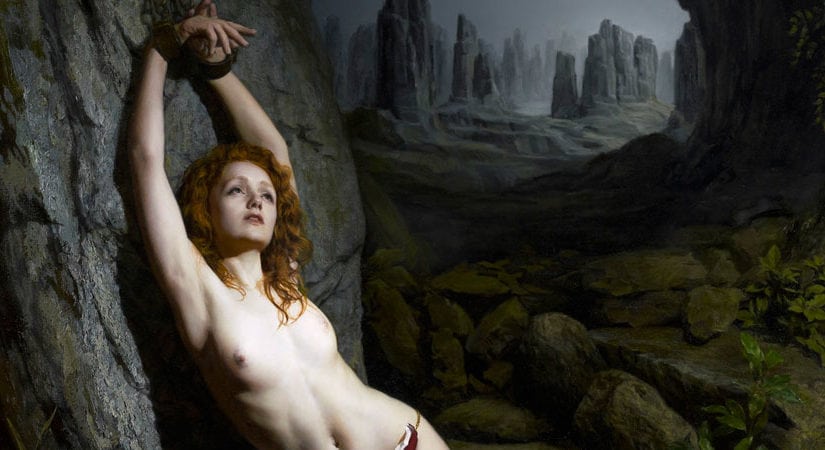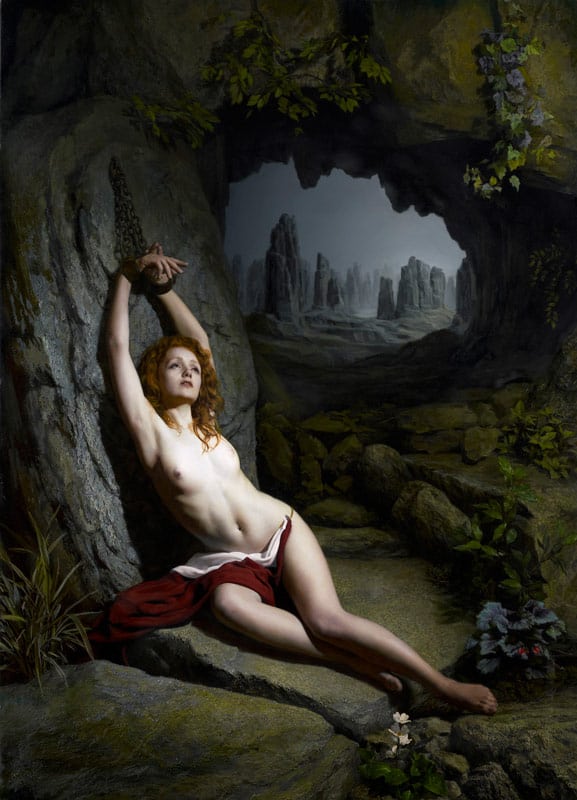Louis Smith was awarded 2nd prize for his portrait of Holly in the BP Portrait Award 2011.
His aim is to create a narrative portrait style. This involves having the sitter as a subject in their own theatrical composition. This style is inspired by tales from myth and legend, and also actual events in history. The idea is to create a larger than life view of the sitter in a role they may aspire to, or as a character they can relate to. Most classical paintings in western art use these themes as a starting point for a composition, so why not use them in portraiture.
read review >>>
Stories from Ancient history and religion have long since been a guide for the morals and beliefs of the human condition. The themes of these tales are often dark, with the hero or heroine battling against adversity, emerging triumphant and stronger for having faced their demons. We can all identify with at least one historical or fictitious character, or possibly with an era in which we would have liked to live. The narratives are used in a way that encourages the sitter to become emotionally invested in the piece and creates an attachment that can be used in a positive way. The portrait may be an affirmation of who they are, or as an inspiration for who they want to be.
Why a narrative portrait? For example, the portrait of Holly is based on the story of Prometheus. He was a champion of mankind who stole fire from Zeus and gave it to mortals. Zeus punished him for his crime by having him bound to a rock while a great eagle ate his liver every day only to have it grow back to be eaten again the next day. Holly is looking into the face of the eagle with a calm resilience, accepting the fate that lies before her. The scene is positive affirmation of endurance, the courage and perseverance to face the suffering of everyday life.
This genre of painting could be viewed by some as egotistical or self centred, however, I view it as a way to paint a portrait that has personal meaning to the subject and in doing so produce a piece of art that will start many a conversation and leave a lasting impression.
For information on the model Holly click here>>>
Bespoke Portrait
The above slideshow illustrates the production of a narrative portrait by Louis Smith. From the conception, to building the scenery, props, wardrobe, lighting and make up. Also a unique frame built to accommodate the painting
A brief history of Narrative Portraits
Nude portraits
Narrative portraits date back to Greece where nobles would commission themselves depicted as educated scholars, warrior type figures, athletes or in a way to pay homage to mythological figures. They would be typically idealised in the nude or some state of undress. The culture celebrated the human form as a higher aesthetic, unlike the western culture of today which is generally inhibited by nudity in art.
Donor Portraits
Most medieval portraits were donor portraits. They are common in religious works of art, especially the paintings of the Middle Ages through to the Renaissance. The donor is usually shown kneeling to one side, in the foreground of the image and late into the Renaissance, the whole family could be shown. By the mid 15th century donors were shown integrated into the main scene, as bystanders and even participants.
As an example patrons commissioning a fresco for a church would have themselves painted into a religious scene, with a hierarchy of those donating the most being the most prominent in the fresco. The Medici family who almost bankrolled the renaissance are to be found in various fresco scenes in churches throughout Florence.

Detail from the Magi Chapel at the Palazzo Medici in Florence.
The above shows a fresco depicting The Procession of The Magi(1459-1460). (The journey of the three wise men to Bethlehem).
The fresco promotes Cosimo de’ Medici, Lorenzo Medici and other prominent Italians. The religious theme was a pretext to show the procession of important people who travelled to the meeting of the Council of Florence (1438-1439). The Fresco is probably the Medici’s boasting about their part in the reconciliation between the Catholic and the Byzantine churches.
Themed portraits
The themed portrait is recognised as becoming more popular in later years. Painters would paint their subjects in period costume or introduce some historical referance so the painting would not appear to date as contemporary fashions change all the time. Rembrant was such an artist dressing many of his patrons in styles and themes 100 years or more.
This tradition has continued through the ages, below is a portrait of Portrait of Madame Récamier. This is an 1800 portrait of Juliette Récamier by Jacques Louis David showing her reclining on an empire style sofa in an empire line dressed as a modern vestal virgin..

Jacques-Louis David, portrait of Madame Récamier (1800), Musée du Louvre, Paris.


